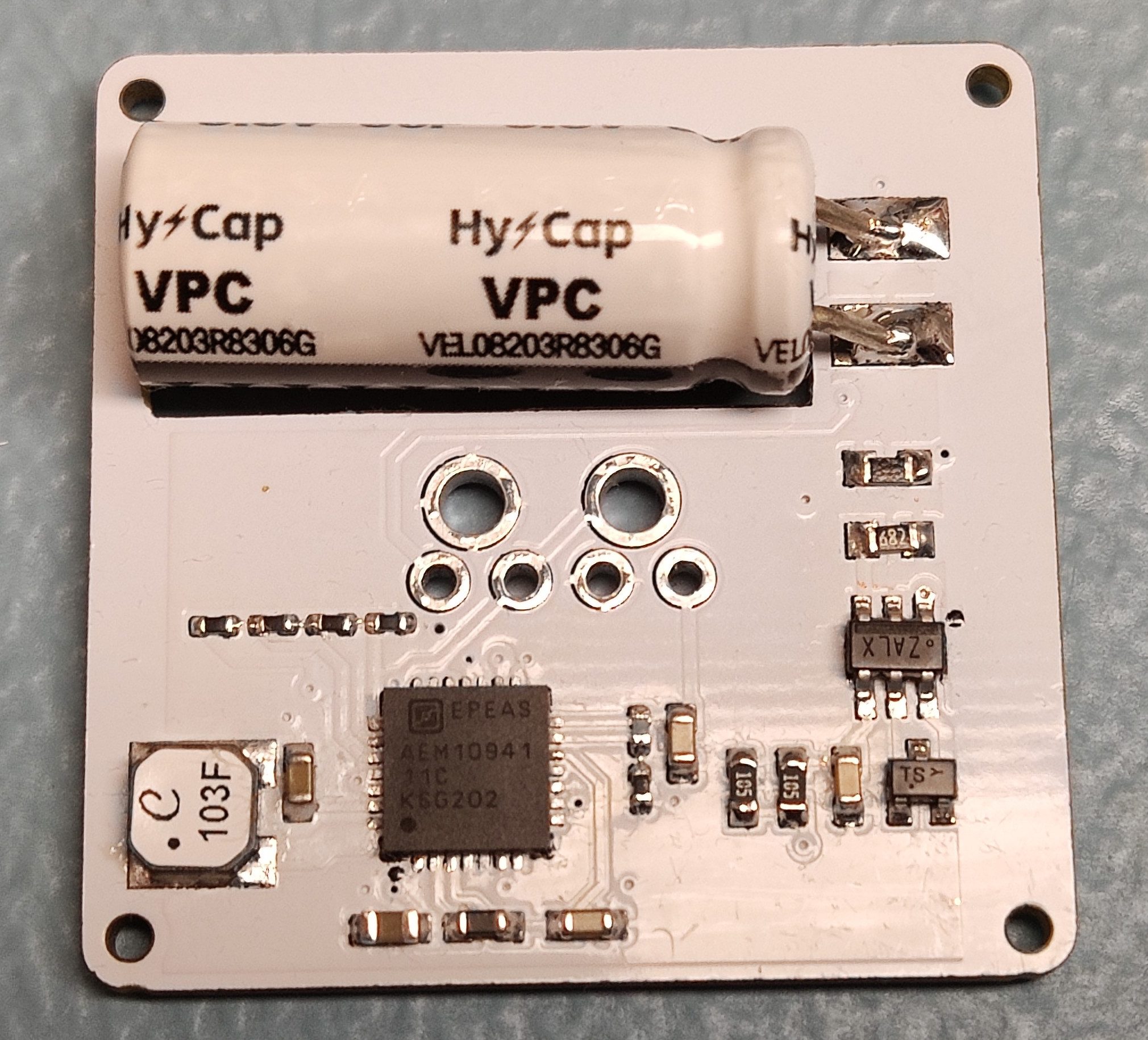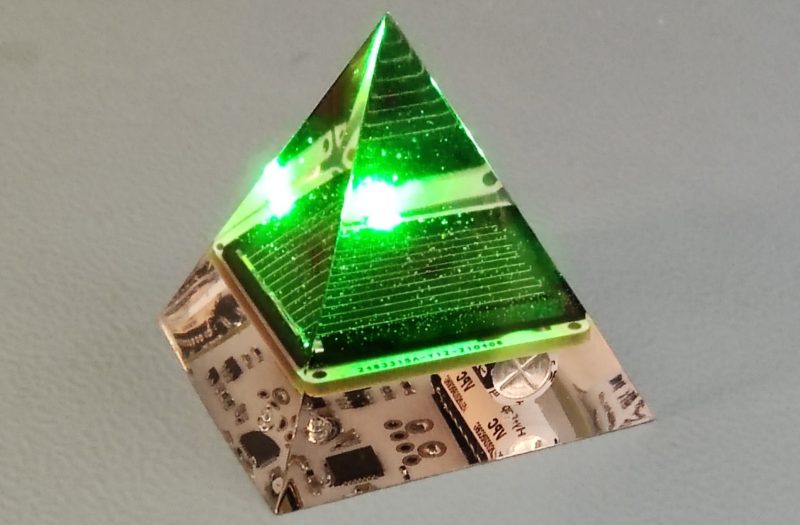Without knowing it, we’ve spent years watching [Jasper Sikken] piece together an empire of energy harvesting equipment, and now he’s putting the pieces together into wonderful creations. His recently finished solar harvesting pyramids are mesmerizing objects of geometric perfection we’d love to see glinting in the sun.
These solar harvesting pyramids are well described by their name. Each one contains a PCBA around 30mm on a side with a solar energy harvester built around the dedicated AEM10941 IC, a single solar cell, and a very bright green LED. [Jasper] calculates that the solar cell will charge the super capacitor at 20uA at with just 200 lux of light (a level typical for casual indoor spaces) letting it run indefinitely when placed indoors. Amazingly with the LED blinking for 15ms every 2 seconds it will run for 21 days in complete darkness. And that’s it! This is a software-free piece of hardware which requires no input besides dim light and blinks an LED indefinitely.

What about that super capacitor? It’s called a Lithium Ion Capacitor (LIC) and is a hybrid between a typical rechargeable lithium battery and an electrolytic capacitor, offering extremely high capacity in a convenient two leg through hole form factor. This one is a whopping 30 Farad at 3.8 V, and we first saw it when [Jasper] won the Hackaday Earth Day contest last month. Check out that link if you want to know more about their uses and how to integrate them.
For more detail about all of the components of the solar pyramid we need only turn to the Hackaday archives. In December 2019 [Tom Nardi] wrote about building a cheap degassing system for making some very familiar looking resin pyramids. And before that [Donald Papp] brought us another familiar piece of the pyramid when he wrote up a different 1″ x 1″ solar harvesting system that [Jasper] designed.
Check out the video after the break to see what one of these gems looks like from all sides. And for many more experiments leading up the final pyramid check out the logs on the Hackaday.io page.















really really nice build!
I still say it was built by aliens!
Nice work…. very pretty electronic pyramid. Great niche. Can think of something similar as a perpetual (?long lasting?) flickering candle for grave markers.
forget flickering candles, I want my grave marker to give out bits of my wisdom to passerbys. ‘what are you looking at?’ ‘and I still smell better than you’ etc etc
Gotcha…
https://www.simpsonsarchive.com/bin/departed.icon.gif
Bet I could get a cheapy solar light to flash LEDs. Maybe not indoors, though without the extortionate visit to Mousie. Love that it was encapsulated in resin, eliminating corrosion…the premature demise of so many solar garden lights. I wonder just how long it might last?
Yeah, its a bit over engineered. Have a look at this: http://moonworm.net/flasher/
Electronics in the garden is never over engineered. Between the weather, pets, other animals, and children, that resin gives it a hope of surviving. You can get cheap outdoor flashing lights, but they last about a year or so.
I gave the MoonWorm ‘Infinite FireFly’ circuit a try. It seems to flash low intensity LEDs from a 1.5V source quite nicely. It is very dim with a 1.2V supply (like in a solar light), or with higher voltage/ intensity LEDs. Never mind, I have a few more flasher circuits to try yet.
Yep, Joule Thief based LED flashers seem to be the go for the low voltage of a solar garden light. They’re a bit fiddly and unpredictable though, I find.
I suspect it will last as long as that hybrid battery capacitor remains functional, far as I know they haven’t been around long enough to really have anything other than artificial accelerated wear levels to guestimate from, but still as the actual power requirements are so low even when its pretty knackered the device aught to work.
About the only thing that could kill such a device quickly is the resin going cloudy, degrading, or damaging the electronics itself (potting with any old resin doesn’t necessary work for long – the resin shrinking as it cures, different thermal expansions etc can actually make using it to pot electronics a bad thing). Any surface degradation would be easy enough to fix too – just throw some plastic polish on a mop and clean up the surface again, giving you another few years of life.
Hi Kerry, could you please correct the capacitor voltage? Its not 2.2V but 3.8V.
Got it.
Funny, I was thinking LiIon battery and cap before reading the article. Those integrated caps look neat!
Might have to build a lower BOM version of this to see what the up-time would be. The quarter cell rechargeable batteries are cheap and pretty robust.
CMOS logic chips have very low quiescent current and can be the basis of very efficient LED flashers. If you take the example here https://hackaday.io/project/28344-10-year-led-flasher and omit the ‘joule thief’ section, you can flash an LED for a few days off a 1UF cap or more than a year off a 2023 coin cell.
Typical electrolytic capacitors have a habit of bulging out after nearly 40 years, or leaking their electrolyte. In retro computer power supplies the electrolytic capacitors are replaced to proactively prevent failure. How does the Lithium Ion Capacitor compare, although I guess that it will be a while until there is enough data for a comparison. And continuous use is a different data point to being powered off for nearly 40 years stored in less than ideal conditions.
Electrolytic capacitors use fluid. That’s the shelf life you’re referring to.
These aren’t (given the “super”) the same in that regard. Here’s a wiki:
https://en.m.wikipedia.org/wiki/Supercapacitor
Found a paywall document that lists the primary Lithium-ion capacitor lifetime stress factors ( https://doi.org/10.1016/j.est.2020.102019 ). It is not explicit, but extrapolating the data would suggest that the working life at room temperature is going to be less than electrolytic capacitors (which are typically greater than 20 years).
Reminds of a deck prism. Which would also looks cool lit up
i need a clock for 10000 years
solar panels? no ;)
Awesome job. I’m curious about the circuit, as maybe it’s a little overkill? You could probably get a flash set up with just an led, cap, and diode and the right resistance on a sort of charge-discharge circuit. Granted, the times between flashes would change as voltage dropped and you would not have anything to keep the voltage stable, but these pieces of electronics can all handle being undervolted, I believe. What drove this style of design? No shade here btw, just playing “circuit golf” and taking an interest. For what it’s worth I did read the build page.